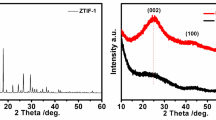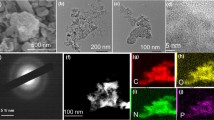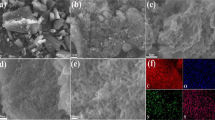Abstract
To improve the oxygen reduction reaction (ORR) performance of biomass-derived carbon materials, N and P co-doped porous carbon ORR catalysts are synthesized by pyrolyzing the mixture containing different of yuba powder and metaphosphate (NaPO3) at 850 ℃ under N2 atmosphere. The as-prepared Y-850-5 contained 4.29 at% of N and 1.13 at% of P. The half-potential and the limiting diffusion current density of Y-850-5 are −0.153 V and −4.78 mA cm-2 @-0.5 V vs. Hg/HgO, respectively, which are improved by 6.5 % and 5.9 % compared to Y-850 (−0.163 V and −4.51 mA cm−2 @-0.5 V vs. Hg/HgO), respectively. DFT calculation indicate that the synergy of N and P co-dope resulted in changing the uniform distribution of electron cloud of carbon and lowering the ORR reaction energy barriers. The above results indicate that NaPO3 can be utilized as P resource to dope and improve the electrochemical performance biomass-derived porous carbon.






Similar content being viewed by others
References
Sun YQ, Wu QO, Shi GQ (2011) Graphene based new energy materials. Energy Environ Sci 4:1113–1132
Fang B, Chaudhari NK, Kim MS, Kim JH, Yu JS (2009) Homogeneous deposition of platinum nanoparticles on carbon black for proton exchange membrane fuel cell. J Am Chem Soc 131:15330–15338
Yamamoto K, Imaoka T, Chun WJ, Enoki O, Katoh H et al (2009) Size-specific catalytic activity of platinum clusters enhances oxygen reduction reactions. Nat Chem 1:397–402
Bing YH, Liu HS, Zhang L, Ghosh D, Zhang JJ (2010) Nanostructured Pt-alloy electrocatalysts for PEM fuel cell oxygen reduction reaction. Chem Soc Rev 39:2184–2202
Debe MK (2012) Electrocatalyst approaches and challenges for automotive fuel cells. Nature 486:43–51
Wu G, Zelenay P (2013) Nanostructured nonprecious metal catalysts for oxygen reduction reaction. Acc Chem Res 46:1878–1889
Nie Y, Li L, Wei ZD (2015) Recent advancements in Pt and Pt-free catalysts for oxygen reduction reaction. Chem Soc Rev 44:2168–2201
Sarkar A, Murugan AV, Manthiram A (2009) Low cost Pd-W nanoalloy electrocatalysts for oxygen reduction reaction in fuel cells. J Mater Chem 19:159–165
Yu JM, Jiang ZK, Wang JG, Fang HY, Huang TZ (2019) Electrocatalytic performance of reduced graphene oxide supported nano-NiZnO2 for oxygen reduction reaction. Mater Chem Phys 232:121–128
Yang Z, Yao Z, Li GF, Fang GY, Nie HG et al (2012) Sulfur-doped graphene as an efficient metal-free cathode catalyst for oxygen reduction. ACS Nano 6:205–211
Feng X, Bai Y, Liu MQ, Li Y, Yang HY et al (2021) Untangling the respective effects of heteroatom-doped carbon materials in batteries, supercapacitors and the ORR to design high performance materials. Energy Environ Sci 14:2036–2089
Zhang W, Wu ZY, Jiang HL, Yu SH (2014) Nanowire-directed templating synthesis of metal-organic framework nanofibers and their derived porous doped carbon nanofibers for enhanced electrocatalysis. J Am Chem Soc 136:14385–14388
Gao SY, Wei XJ, Liu HY, Geng K, Wang HQ et al (2015) Transformation of worst weed into N-, S-, and P-tridoped carbon nanorings as metal-free electrocatalysts for the oxygen reduction reaction. J. Mater. Chem. A 3:23376–23384
Yang XX, Li K, Lv JQ, Chen XY, Zang HY et al (2018) N-doped hierarchical porous carbon nanomeshes as oxygen reduction in pH-universal media and oxygen evolution electrocatalysts. ChemElectroChem 5:3279–3286
Gao SY, Li XG, Li LY, Wei XJ (2017) A versatile biomass derived carbon material for oxygen reduction reaction, supercapacitors and oil/water separation. Nano Energy 33:334–342
Rana M, Subramani K, Sathish M, Gautam UK (2017) Soya derived heteroatom doped carbon as a promising platform for oxygen reduction, supercapacitor and CO2 capture. Carbon 114:679–689
Pan FP, Cao ZY, Zhao QP, Liang HY, Zhang JY (2014) Nitrogen-doped porous carbon nanosheets made from biomass as highly active electrocatalyst for oxygen reduction reaction. J Power Sources 272:8–15
Gao SY, Chen YL, Fan H, Wei XJ, Hu CG et al (2014) Large scale production of biomass-derived N-doped porous carbon spheres for oxygen reduction and supercapacitors. J. Mater. Chem. A 2:3317–3324
Gao SY, Fan H, Zhang SX (2014) Nitrogen-enriched carbon from bamboo fungus with superior oxygen reduction reaction activity. J. Mater. Chem. A 2:18263–18270
Gao SY, Chen YL, Fan H, Wei XJ, Hu CG et al (2014) A green one-arrow-two-hawks strategy for nitrogen-doped carbon dots as fluorescent ink and oxygen reduction electrocatalysts. J. Mater. Chem. A 2:6320–6325
Qi JW, Zhang WD, Xu L (2018) Solvent-free mechanochemical preparation of hierarchically porous carbon for supercapacitor and oxygen reduction reaction. Chem.-Eur. J. 24:18097–18105
Tang JH, Wang YJ, Zhao WQ, Zeng RJX, Liu T et al (2019) Biomass-derived hierarchical honeycomb-like porous carbon tube catalyst for the metal-free oxygen reduction reaction. J Electroanal Chem 847:7
Yan XC, Jia Y, Zhuang LZ, Zhang LZ, Wang K et al (2018) Defective carbons derived from macadamia nut shell biomass for efficient oxygen reduction and supercapacitors. ChemElectroChem 5:1874–1879
Xu JH, Xia CL, Li M, Xiao R (2019) Porous nitrogen-doped carbons as effective catalysts for oxygen reduction reaction synthesized from cellulose and polyamide. ChemElectroChem 6:5735–5743
Wutscher A, Eckhard T, Hiltrop D, Lotz K, Schuhmann W et al (2019) Nitrogen-doped metal-free carbon materials derived from cellulose as electrocatalysts for the oxygen reduction reaction. ChemElectroChem 6:514–521
Choi CH, Park SH, Woo SI (2012) Binary and ternary doping of nitrogen, boron, and phosphorus into carbon for enhancing electrochemical oxygen reduction activity. ACS Nano 6:7084–7091
Song P, Bo XJ, Nsabimana A, Guo LP (2014) Additional doping of phosphorus into polypyrrole functionalized nitrogenous carbon nanotubes as novel metal-free oxygen reduction electrocatalyst in alkaline solution. Int J Hydrogen Energy 39:15464–15473
Wang MR, Li Y, Fang J, Villa CJ, Xu YB et al (2020) Superior oxygen reduction reaction on phosphorus-doped carbon dot/graphene aerogel for all-solid-state flexible al-air batteries. Adv Energy Mater 10:8
Wu J, Yang ZR, Li XW, Sun QJ, Jin C et al (2013) Phosphorus-doped porous carbons as efficient electrocatalysts for oxygen reduction. J. Mater. Chem. A 1:9889–9896
Zhang ZP, Sun JT, Dou ML, Jo J, Wang F (2017) Nitrogen and phosphorus codoped mesoporous carbon derived from polypyrrole as superior metal-free electrocatalyst toward the oxygen reduction reaction. ACS Appl Mater Interfaces 9:16236–16242
Li JS, Li SL, Tang YJ, Li K, Zhou L et al (2014) Heteroatoms ternary-doped porous carbons derived from MOFs as metal-free electrocatalysts for oxygen reduction reaction. Sci Rep 4:8
Xie YP, Yang Y, Zhou QJ, Wang LL, Yao YQ et al (2019) Metal-free N, P-codoped porous carbon fibers for oxygen reduction reactions. J Electrochem Soc 166:H549–H555
Ge LP, Wang D, Yang PX, Xu H, Xiao LH et al (2019) Graphite N-C-P dominated three-dimensional nitrogen and phosphorus co-doped holey graphene foams as high-efficiency electrocatalysts for Zn-air batteries. Nanoscale 11:17010–17017
Chen YM, Yamaguchi S, Ono T (2009) Mechanism of the chemical composition changes of yuba prepared by a laboratory processing method. J Agric Food Chem 57:3831–3836
Zhao CJ, Liu GQ, Sun N, Zhang X, Wang GZ et al (2018) Biomass-derived N-doped porous carbon as electrode materials for Zn-air battery powered capacitive deionization. Chem Eng J 334:1270–1280
Riahifard N, Mozaffari S, Aldakhil T, Nunez F, Alshammari Q et al (2018) Design, synthesis, and evaluation of amphiphilic cyclic and linear peptides composed of hydrophobic and positively-charged amino acids as antibacterial agents. Molecules 23:11
Ma YH (2017) Comparison of activated carbons prepared from wheat straw via ZnCl2 and KOH activation. Waste Biomass Valorization 8:549–559
Yu HT, Li YC, Li XH, Fan LZ, Yang SH (2014) Electrochemical preparation of N-doped cobalt oxide nanoparticles with high electrocatalytic activity for the oxygen-reduction reaction. Chem.-Eur. J. 20:3457–3462
Li YL, Wang JJ, Li XF, Liu J, Geng DS et al (2011) Nitrogen-doped carbon nanotubes as cathode for lithium-air batteries. Electrochem Commun 13:668–672
Lim S, Yoon SH, Mochida I, Jung DH (2009) Direct synthesis and structural analysis of nitrogen-doped carbon nanofibers. Langmuir 25:8268–8273
Liu XJ, Zhou YC, Zhou WJ, Li LG, Huang SB et al (2015) Biomass-derived nitrogen self-doped porous carbon as effective metal-free catalysts for oxygen reduction reaction. Nanoscale 7:6136–6142
Kim H, Cho J, Jang SY, Song YW (2011) Deformation-immunized optical deposition of graphene for ultrafast pulsed lasers. Appl Phys Lett 98:3
Sun Y, Du X, Zhang J, Huang N, Yang L et al (2020) Microwave-assisted preparation and improvement mechanism of carbon nanotube@NiMn2O4 core-shell nanocomposite for high performance asymmetric supercapacitors. J. Power Sources 473:228609
Twinkle AR, Leenaraj DR, Ratkovic Z, Arunsasi BS, Bright KC et al (2020) Ferrocenyl chalcone derivative (E)-3-(2-methylpyrimidin-5-yl)-1-ferroceynlprop-2-en-1-one: synthesis, structural analysis, Docking study and their Antibacterial evaluation. J Mol Struct 1210:9
Michota A, Bukowska J (2003) Surface-enhanced Raman scattering (SERS) of 4-mercaptobenzoic acid on silver and gold substrates. J Raman Spectrosc 34:21–25
Sun Y, Zhang JJ, Sun XN, Huang NB (2019) The NH4F-induced morphology control of hierarchical CoO@MnO2 core-shell arrays for high performance supercapacitor electrodes. CrystEngComm 21:7468–7475
Sun Y, Zhang JJ, Sun XN, Huang NB (2020) High-performance spinel NiMn2O4 microspheres self-assembled with nanosheets by microwave-assisted synthesis for supercapacitors. CrystEngComm 22:1645–1652
Lee JS, Kim SI, Yoon JC, Jang JH (2013) Chemical vapor deposition of mesoporous graphene nanoballs for supercapacitor. ACS Nano 7:6047–6055
Guo CZ, Liao WL, Li ZB, Chen CG (2015) Exploration of the catalytically active site structures of animal biomass-modified on cheap carbon nanospheres for oxygen reduction reaction with high activity, stability and methanol-tolerant performance in alkaline medium. Carbon 85:279–288
Yi JN, Qing Y, Wu CT, Zeng YX, Wu YQ et al (2017) Lignocellulose-derived porous phosphorus-doped carbon as advanced electrode for supercapacitors. J Power Sources 351:130–137
Liu ZW, Peng F, Wang HJ, Yu H, Zheng WX et al (2012) Preparation of phosphorus-doped carbon nanospheres and their electrocatalytic performance for O-2 reduction. J Nat Gas Chem 21:257–264
Schonfelder HH, Kitoh K, Nemoto H (1997) Nanostructure criteria for lithium intercalation in non-doped and phosphorus-doped hard carbons. J Power Sources 68:258–262
Hu XW, Fan MY, Zhu YY, Zhu Q, Song Q et al (2019) Biomass-derived phosphorus-doped carbon materials as efficient metal-free catalysts for selective aerobic oxidation of alcohols. Green Chem 21:5274–5283
Liu RL, Wu DQ, Feng XL, Mullen K (2010) Nitrogen-doped ordered mesoporous graphitic arrays with high electrocatalytic activity for oxygen reduction. Angew. Chem.-Int. Edit. 49:2565–2569
Wu G, More KL, Johnston CM, Zelenay P (2011) High-performance electrocatalysts for oxygen reduction derived from polyaniline, iron, and cobalt. Science 332:443–447
Zhong HX, Zhang HM, Liu SS, Deng CW, Wang MR (2013) Nitrogen-enriched carbon from melamine resins with superior oxygen reduction reaction activity. Chemsuschem 6:807–812
McEwen JS, Bray JM, Wu C, Schneider WF (2012) How low can you go? Minimum energy pathways for O-2 dissociation on Pt(111). Phys Chem Chem Phys 14:16677–16685
Yu L, Pan XL, Cao XM, Hu P, Bao XH (2011) Oxygen reduction reaction mechanism on nitrogen-doped graphene: a density functional theory study. J Catal 282:183–190
Ou LH (2014) The origin of enhanced electrocatalytic activity of Pt-M (M = Fe Co, Ni, Cu, and W) alloys in PEM fuel cell cathodes: a DFT computational study. Comput Theor Chem 1048:69–76
Man IC, Su HY, Calle-Vallejo F, Hansen HA, Martinez JI et al (2011) Universality in oxygen evolution electrocatalysis on oxide surfaces. ChemCatChem 3:1159–1165
Norskov JK, Rossmeisl J, Logadottir A, Lindqvist L, Kitchin JR et al (2004) Origin of the overpotential for oxygen reduction at a fuel-cell cathode. J Phys Chem B 108:17886–17892
Acknowledgements
We sincerely acknowledge Professor Hendrik Heinz of the University of Colorado-Boulder for providing computing resources, including Dmol3 and Castep modules in Material Studio software.
Funding
This work was supported by the National Natural Science Foundation of China (No. 21676040), the Natural Science Foundation of Liaoning Province (2019JH3/30100009), Cultivation Program for the Excellent Doctoral Dissertation of Dalian Maritime University (0143210269), and Dalian Science and Technology Innovation Funds (2018J12GX053, 2020JJ26GX042).
Author information
Authors and Affiliations
Corresponding authors
Ethics declarations
Conflict of interest
The authors declare no competing interests.
Additional information
Publisher's note
Springer Nature remains neutral with regard to jurisdictional claims in published maps and institutional affiliations.
Supplementary Information
Below is the link to the electronic supplementary material.
Rights and permissions
About this article
Cite this article
Junjie, Z., Yin, S., Likui, G. et al. Adding NaPO3 improving the ORR performance of N-doped porous carbon material derived from yuba. Ionics 28, 3389–3397 (2022). https://doi.org/10.1007/s11581-022-04560-0
Received:
Accepted:
Published:
Issue Date:
DOI: https://doi.org/10.1007/s11581-022-04560-0




